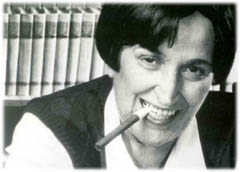She was also Franklin D. Roosevelt’s confidential investigative reporter for the Federal Emergency Relief Administration (FERA) during the Great Depression. Her reports to FDR helped shape government policy.
Her great friendship with Eleanor began shortly before Eleanor became First Lady and some researchers claim Hickok was “the woman behind the woman.”
The Provincetown Fringe Festival continues to honor Pat Bond, her life and works and her contribution to the gay and lesbian community as an actor, comedian, and playwright. Bond cared about knowledge, fighting injustice, the plight of older lesbians and making people laugh no matter what the situation.
| A Dual Chronology of Lorena and Eleanor |
| Years |
Eleanor Roosevelt (ER) |
Lorena Hickok (LH) |
| 1880-1889 |
1884: Anna Eleanor Roosevelt born in New York
City. |
|
| 1890-1899 |
1894: Father dies (her mother had died 2 years
earlier).
1899: Attends Mme. Souvestre’s
Allenswood boarding school (near London). |
1893: Lorena Hickok born in rural
Wisconsin. |
| 1900-1909 |
1900: First political activism (incl. settlement
house work).
1905: Marries her distant cousin, Franklin
D. Roosevelt (FDR). |
1907: Lorena’s mother dies; Lorena
moves to Michigan. |
| 1910-1919 |
1912
on: Active in various political and social organizations.
1918: Discovers Franklin’s affair with
Lucy Mercer; at some point, ER and FDR’s relationship changes from
marriage to friendship and political partnership. |
1913:
Begins her career in journalism.
1917: Hired by the Minneapolis
Tribune; achieves considerable success and choice assignments. |
| 1920-1929 |
ER’s political/social
activities continue during the decade.
1920: Joins FDR on the campaign trail.
1921: Nurses Franklin after he contracts
polio, encouraging his continuing involvement in politics. ER serves as a
primary advisor until FDR’s death.
1926: Purchases Todhunter School for Girls
with friends Marion Dickerman and Nancy Cook.
1928: Franklin elected governor of New
York. |
1927: Moves to New York City; writes for
the New York Daily Mirror; career continues to thrive.
1928: Covers FDR’s New York
gubernatorial campaign. |
| 1930-1939 |
1932: Travels extensively, campaigning for FDR for
President.
1933: Becomes First Lady: holds press
conferences of her own, writes columns and books, corresponds with the public,
and continues to work for progressive causes throughout.
1939: Resigns from Daughters of the
American Revolution when they refuse to allow Marian Anderson to perform in
their hall; ER arranges for her concert at the Lincoln Memorial. |
1932: Assigned to cover Eleanor Roosevelt during the
presidential campaign; meets her and writes a series of interviews.
1932-1933: ER and LH’s relationship
develops and deepens; LH advises ER on many matters related to being First
Lady.
1933: Resigns from the Associated Press
(due to the inherent conflicts of interest arising from her relationship with
ER ).
1933-1936: Travels and writes field reports
for Harry Hopkins (Federal Emergency Relief Agency) on conditions in
Depression-era America .
1936: Moves to Long Island; works for a PR
firm. |
| 1940-1949 |
1945: FDR dies.
1945: Appointed to US
delegation to the United Nations.
1948: Presents Universal Declaration of Human Rights to UN General
Assembly. |
1940: Moves to Washington, DC, working for the
Democratic National Committee.
1941-1944: Lives in the
White House.
1945: Health problems cause her to resign
from public life. Moves to a cottage in Hyde Park. In subsequent years, she
writes a series of biographies aimed at elementary school readers. |
| 1950-1959 |
Continues to work for the rights
of women, minorities, workers and the poor.
Opposes McCarthy and McCarthyism. |
1954:
Writes Ladies of Courage with ER. |
| 1960-1969 |
1962: Eleanor dies on November 7th. |
1962: Lorena does not attend ER’s funeral but
visits her grave in secret that night.
1968: Lorena dies in near poverty and
obscurity. |
 |
Empty Without You: The Intimate Letters of Eleanor
Roosevelt and Lorena Hickok, ed. by
Rodger
Streitmatter (Da Capo Press, 2000). [Now available in paperback and as an
eBook.] |
  |
Eleanor Roosevelt, 1884-1933 and Eleanor Roosevelt:
Volume 2, The Defining Years, 1933-1938, by Blanche Wiesen Cook (Penguin,
1993 and 2000). |
 |
The Life of Lorena Hickok: E.R.’s Friend, by Doris
Faber (William Morrow and Company, 1980). [Although Faber denies the sexual
dimension of LH and ER’s relationship, the book contains lots of
information about Hickok’s life.] |





